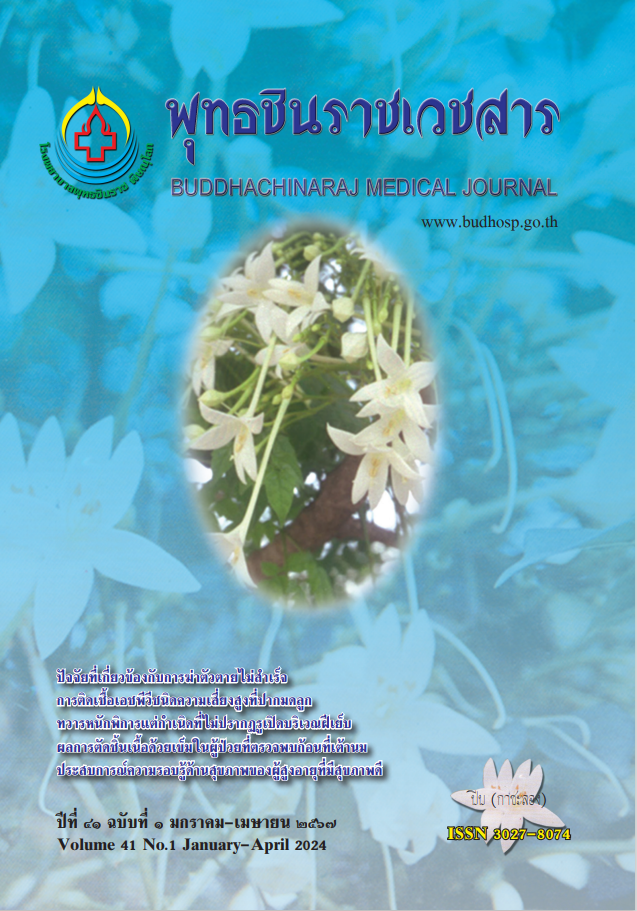ลักษณะทางคลินิกที่สำคัญในการทำนายภาวะต่อมน้ำเหลืองโตผิดปกติในเด็ก
ภาวะต่อมน้ำเหลืองโตผิดปกติในเด็ก
คำสำคัญ:
ภาวะต่อมน้ำเหลืองโต, เด็ก, การตัดต่อมน้ำเหลือง, มะเร็งบทคัดย่อ
ภาวะต่อมน้ำเหลืองโตในเด็กพบได้บ่อย ส่วนใหญ่เป็นต่อมน้ำเหลืองโตที่คลำได้ปกติ ขณะที่ต่อมน้ำเหลืองโตผิดปกติพบได้น้อยกว่าและมักมีลักษณะทางคลินิกที่ต่างออกไป ดังนั้นการวิจัยแบบทำนายการวินิจฉัยครั้งนี้จึงมีวัตถุประสงค์เพื่อประเมินลักษณะทางคลินิกที่ใช้ทำนายภาวะต่อมน้ำเหลืองโตผิดปกติ โดยเก็บข้อมูลย้อนหลังจากเวชระเบียนผู้ป่วยเด็กอายุน้อยกว่า 15 ปีที่ได้รับการตัดต่อมน้ำเหลืองเพื่อวินิจฉัยภาวะต่อมน้ำเหลืองโตที่โรงพยาบาลพุทธชินราช พิษณุโลกระหว่างเดือนมกราคม พ.ศ. 2555 ถึงเดือนธันวาคม พ.ศ. 2565 วิเคราะห์ลักษณะที่ทำนายรายตัวด้วย univariable risk ratio regression และลักษณะที่ทำนายหลายตัวด้วย multinomial logistic regression ผลการศึกษาพบว่าเด็กที่ได้รับการตรวจชิ้นเนื้อ 188 ราย เป็นกลุ่มต่อมน้ำเหลืองโตผิดปกติที่ไม่ใช่มะเร็ง 70 ราย (ร้อยละ 37.2) และมะเร็ง 27 ราย (ร้อยละ 14.4) ปัจจัยที่ใช้ทำนายภาวะต่อมน้ำเหลืองโตผิดปกติที่ไม่ใช่มะเร็ง คือ ต่อมน้ำเหลืองโตที่เดียว, คลำต่อมน้ำเหลืองพบลักษณะ rubbery และ fixed ส่วนลักษณะที่บ่งบอกถึงภาวะมะเร็ง คือ ขนาดของต่อมน้ำเหลืองโตกว่า 1.5 เซนติเมตร, ต่อมน้ำเหลืองโตหลายที่, ภาวะซีด อ่อนเพลีย และคลำต่อมน้ำเหลืองพบลักษณะ fixed สรุปได้ว่าเมื่อนำลักษณะทางคลินิกเหล่านี้มาใช้จะช่วยให้จัดทำแนวทางในการรักษาและตรวจชิ้นเนื้อได้อย่างเหมาะสม
เอกสารอ้างอิง
Alves Rosa J, Calle-Toro JS, Kidd M, Andronikou S. Normal head and neck lymph nodes in the paediatric population. Clin Radiol 2021;76(4):315.e1-.e7. doi: 10.1016/j.crad.2020.12.020
Farndon S, Behjati S, Jonas N, Messahel B. How to use… lymph node biopsy in paediatrics. Arch Dis Child: Educ Pract Ed 2017;102(5):244-8. doi: 10.1136/archdischild-2015-309634
Grant CN, Aldrink J, Lautz TB, Tracy ET, Rhee DS, Baertschiger RM, et al. Lymphadenopathy in children: A streamlined approach for the surgeon — A report from the APSA Cancer Committee. J Pediatr Surg 2021;56(2):274-81. doi: 10.1016/j.jpedsurg.2020.09.058
Locke R, Comfort R, Kubba H. When does an enlarged cervical lymph node in a child need excision? A systematic review. Int J Pediatr Otorhinolaryngol 2014;78(3):393-401. doi: 10.1016/j.ijporl.2013.12.011
Nolder AR. Paediatric cervical lymphadenopathy: When to biopsy? Curr Opin Otolaryngol Head Neck Surg 2013;21(6):567-70. doi: 10.1097/moo.0000000000000003
Şen HS, Ocak S, Yılmazbaş P. Children with cervical lymphadenopathy: Reactive or not? Turk J Pediatr 2021;63(3):363-71. doi: 10.24953/turkjped.2021.03.003
Celenk F, Baysal E, Aytac I, Durucu C, Sari I, Mumbuc S, et al. Incidence and predictors of malignancy in children with persistent cervical lymphadenopathy. Int J Pediatr Otorhinolaryngol 2013;77(12):2004-7. doi: 10.1016/j.ijporl.2013.09.022
Mohseni S, Shojaiefard A, Khorgami Z, Alinejad S, Ghorbani A, Ghafouri A. Peripheral lymphadenopathy: Approach and diagnostic tools. Iran J Med Sci 2014;39(2 Suppl):158-70.
Tokuda Y, Kishaba Y, Kato J, Nakazato N. Assessing the validity of a model to identify patients for lymph node biopsy. Medicine (Baltimore) 2003;82(6):414-8. doi: 10.1097/01.md.0000100047.15804.b6
Twist CJ, Link MP. Assessment of lymphadenopathy in children. Pediat Clin N 2002;49(5):1009-25. doi: 10.1016/s0031-3955(02)00038-x
Weinstock MS, Patel NA, Smith LP. Pediatric cervical lymphadenopathy. Pediatr Rev 2018;39(9):433-43. doi: 10.1542/pir.2017-0249
Berce V, Rataj N, Dorič M, Zorko A, Kolarič T. Association between the clinical, laboratory and ultrasound characteristics and the etiology of peripheral lymphadenopathy in children. Children (Basel) 2023;10(10):1589. doi.org/10.3390/children10101589
Niedzielska G, Kotowski M, Niedzielski A, Dybiec E, Wieczorek P. Cervical lymphadenopathy in children—Incidence and diagnostic management. Int J Pediatr Otorhinolaryngol 2007;71(1):51-6. doi: 10.1016/j.ijporl.2006.08.024
Zijtregtop EAM, Winterswijk LA, Beishuizen TPA, Zwaan CM, Nievelstein RAJ, Meyer-Wentrup FAG, et al. Machine learning logistic regression model for early decision making in referral of children with cervical lymphadenopathy suspected of lymphoma. Cancers (Basel) 2023;15(4):1178. doi: 10.3390/cancers15041178
Somcharoenwattana P. Pathologic lymph node results and the risk factors of malignancy in the patients who presented with cervicallymphadenopathy at Otolaryngology department, Phatthalung hospital. Phatthalung Hospital. Reg 11 Med J 2019;32(4):1407-18.
Seth V, Kabra SK, Jain Y, Semwal OP, Mukhopadhyaya S, Jensen RL. Tubercular lymphadenitis: clinical manifestations. Indian J Pediatr 1995;62(5):565-70. doi: 10.1007/bf02761878
Soldes OS, Yunger JG, Hirschl RB. Predictors of malignancy in childhood peripheral lymphadenopathy. J Pediatr Surg 1999;34(10):1447-52. doi: 10.1016/S0022-3468(99)90101-X
ดาวน์โหลด
เผยแพร่แล้ว
ฉบับ
ประเภทบทความ
สัญญาอนุญาต
ลิขสิทธิ์ (c) 2024 ``โรงพยาบาลพุทธชินราช พิษณุโลก

อนุญาตภายใต้เงื่อนไข Creative Commons Attribution-NonCommercial-NoDerivatives 4.0 International License.






